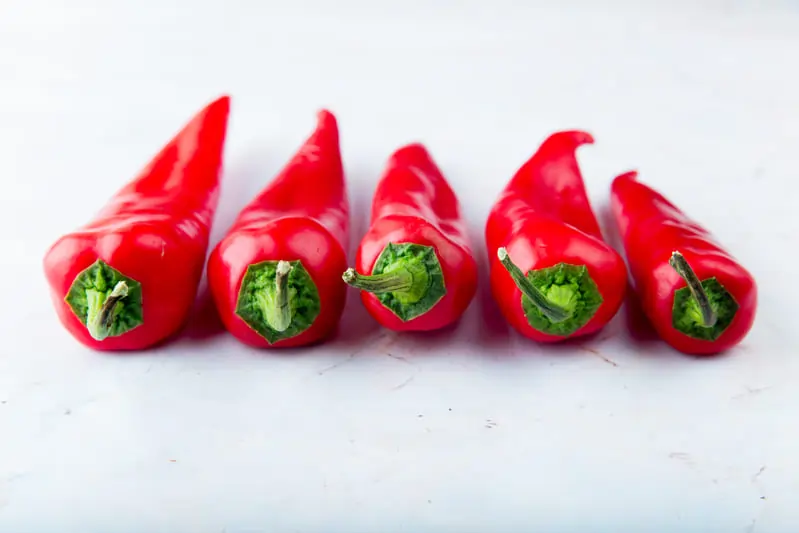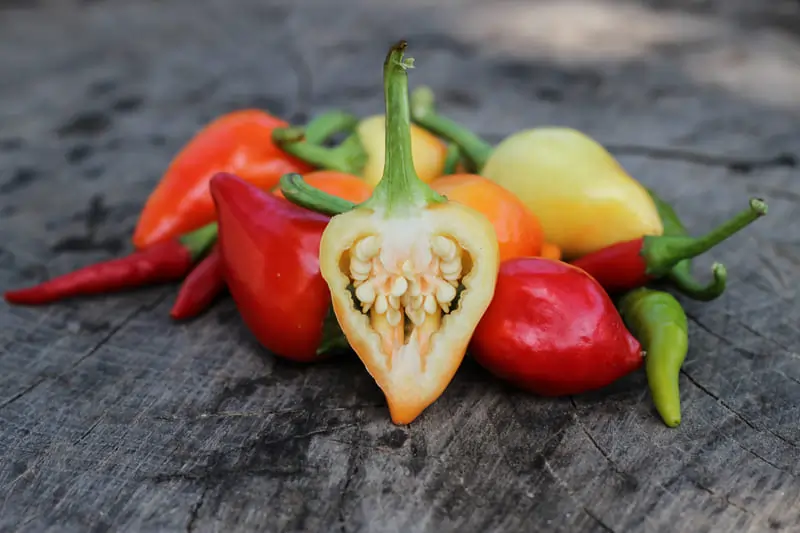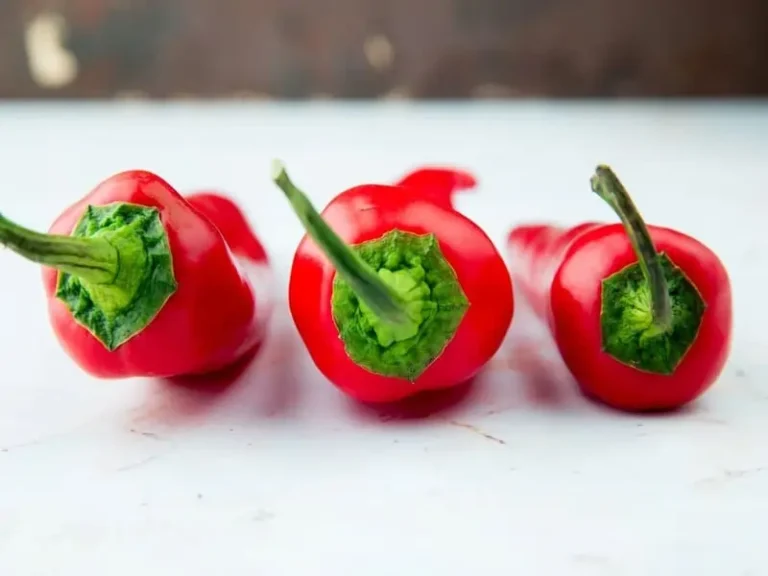Five hottest peppers well explained. For spice enthusiasts, the allure of hot peppers lies in their intense heat and unique flavors. With a scale to measure their spiciness—the Scoville Heat Scale (SHU)—the hottest peppers challenge even the bravest taste buds. From culinary competitions to record-breaking achievements, hot peppers capture our imagination.
To truly appreciate the heat, it’s essential to understand how peppers are ranked. The Scoville Scale, originally developed by Wilbur Scoville, measures the capsaicin content in peppers. Curious about the different types of peppers? Explore this guide to understanding pepper varieties for a deeper dive.
What Makes a Pepper Hot?

If you’re exploring the benefits of eating peppers, check out this article on their health advantages.
The Five Hottest Peppers
The world of hot peppers is a fiery one, dominated by varieties that bring intense heat and unique flavors to the table. These peppers are often used sparingly, primarily in hot sauces and specialty dishes, making them a challenge for even the most adventurous spice lovers. Here’s a closer look at the five hottest peppers.
1. Pepper X
Scoville Heat Units (SHU): 2,693,000
Origins and Characteristics
Ed Currie, the creator of the Carolina Reaper, developed Pepper X, which is officially the hottest pepper in the world. Its heat is nearly unbearable, and even a small amount leaves a lasting impression.
Culinary Uses
Most people avoid using Pepper X fresh because of its intense heat. Instead, chefs and enthusiasts incorporate it into extreme hot sauces specifically designed for spice lovers. However, if you enjoy experimenting with peppers but prefer milder options, you can start with Old-Fashioned Stuffed Bell Peppers. These showcase the natural sweetness of bell peppers in a flavorful dish. This approach allows you to explore the versatility of peppers without overwhelming your taste buds.
2. Carolina Reaper
- Scoville Heat Units (SHU): 2,200,000
- Origins and Characteristics: Once the Guinness World Record holder, the Carolina Reaper combines intense heat with a fruity undertone, it makes it a favorite among chili aficionados.
- Culinary Uses: This pepper is often blended into hot sauces or used in marinades where its heat can be balanced with sweeter or tangy ingredients. For a milder pepper option, try using sweet bell peppers, which pair beautifully with roasted vegetables or as a base for stuffed recipes. Discover how to prepare these with Should You Peel Eggplant for Eggplant Parmesan?, which offers tips for working with different vegetables.
3. Trinidad Moruga Scorpion
- Scoville Heat Units (SHU): 2,009,231
- Origins and Characteristics: Native to Trinidad and Tobago, this pepper is celebrated for its unique blend of sweetness and heat. Its rich flavor profile makes it a versatile choice for those who enjoy a fiery kick with depth.
- Culinary Uses: The Trinidad Moruga Scorpion shines in sauces and marinades, where its natural sweetness enhances grilled meats or vegetables. Adding just a small amount to a dish can elevate its complexity without overwhelming the palate.
4. 7 Pot Douglah
- Scoville Heat Units (SHU): 1,853,936
- Origins and Characteristics: Known for its dark, wrinkled skin, the 7 Pot Douglah is prized for its smoky flavor. Also, This variety is particularly popular in spicy cuisines that emphasize bold and robust flavors.
- Culinary Uses: Use the 7 Pot Douglah in spicy stews or smoked chili recipes, where its smokiness can complement earthy ingredients like beans and lentils. For lighter dishes, balance its heat with a creamy base such as coconut milk.
5. 7 Pot Primo
- Scoville Heat Units (SHU): 1,469,000
- Origins and Characteristics: Originating in Louisiana, the 7 Pot Primo offers a citrusy heat that works exceptionally well in tropical-inspired meals and seafood dishes.
- Culinary Uses: Add the 7 Pot Primo to citrus marinades for shrimp or fish, or use it to enhance tropical salsas with pineapple or mango. For milder heat, consider experimenting with Thai Bird’s Eye Peppers, as discussed in Rare and Unique Pepper Varieties.
How the Scoville Scale Works
The Scoville Scale is the standard measurement used to determine a pepper’s heat level, providing insight into the spiciness of different varieties. Named after its creator, Wilbur Scoville, this scale quantifies heat by measuring the concentration of capsaicin—the chemical compound responsible for a pepper’s fiery sensation.
Capsaicin Concentration and Heat Levels
- Capsaicin’s Role: Capsaicin activates pain receptors in the tongue, creating the sensation of heat. The higher the capsaicin content, the spicier the pepper. For instance, mild peppers like bell peppers contain no capsaicin, resulting in a Scoville Heat Unit (SHU) score of 0, while peppers like the Carolina Reaper score over 2,000,000 SHU.
- What SHU Represents: Scoville Heat Units reflect the dilution ratio required to neutralize a pepper’s heat. For example, a jalapeño rated at 5,000 SHU would need to be diluted 5,000 times before its spiciness becomes undetectable.
Modern Measurement Techniques For The Five hottest peppers.
- High-Performance Liquid Chromatography (HPLC): While Scoville’s original method relied on taste testers, modern technology has improved accuracy. HPLC measures the precise amount of capsaicinoids in a pepper, providing a reliable SHU score. This scientific approach ensures consistency across different pepper batches.
- Impact on Cooking: Knowing the SHU of a pepper allows cooks to balance flavors effectively. For instance, adding a high-SHU pepper like the Trinidad Moruga Scorpion requires careful portioning to avoid overpowering a dish.
Incorporating Peppers of Different Heat Levels
- Balancing Flavors: Using a mix of pepper types allows you to blend heat and sweetness. For instance, pairing the mildness of bell peppers with the boldness of Thai Bird’s Eye Peppers creates depth in stir-fries or curries. For tips on working with vegetables in flavorful dishes, check out Should You Peel Eggplant for Eggplant Parmesan?.
- Creative Recipes: Try using peppers like jalapeños or habaneros in salsas or sauces, ensuring that their heat complements other ingredients without overwhelming them. For inspiration, explore Old-Fashioned Stuffed Bell Peppers for ideas on incorporating peppers into classic recipes.
Understanding how the Scoville Scale works allows you to confidently select and use peppers in your cooking. Whether you’re looking for a hint of spice or a fiery kick, this scale helps ensure the perfect balance of heat and flavor in your dishes. For additional ideas on blending pepper varieties, Understand Substitute for Eggs in Breading Eggplant? for creative techniques to enhance your recipes.
Health Effects of Eating Spicy Peppers
Benefits of Eating Spicy Peppers
- Boosts Metabolism:
Capsaicin has been shown to increase energy expenditure, which helps the body burn calories more efficiently. By raising the body’s temperature slightly, capsaicin enhances fat oxidation, making it a valuable addition to weight management diets. Incorporating peppers like jalapeños or cayenne into dishes not only adds flavor but also supports metabolic health. For inspiration on using peppers in recipes. - Pain Relief:
Capsaicin is commonly used in topical creams to alleviate pain from conditions like arthritis or neuropathy. By temporarily desensitizing nerve receptors, it reduces pain signals and provides relief for localized pain. This makes spicy peppers not just a culinary ingredient but also a therapeutic one. - Cardiovascular Benefits:
Capsaicin may contribute to heart health by lowering cholesterol levels, improving circulation, and reducing the risk of blood clots. Studies suggest that regular consumption of capsaicin-rich foods may help improve vascular health, benefiting those with hypertension or high cholesterol. To explore more ways to incorporate heart-healthy vegetables into your diet, visit Should You Peel Eggplant for Eggplant Parmesan?, which focuses on nutritious meal preparation.
Risks of Eating Spicy Peppers
- Gastrointestinal Discomfort:
While moderate consumption of spicy peppers is generally safe, excessive intake can irritate the lining of the stomach, leading to discomfort, bloating, or heartburn. Individuals with acid reflux or sensitive stomachs may want to limit their consumption of extremely hot peppers like the Carolina Reaper. Balancing spicy ingredients with cooling elements like yogurt or coconut milk can help mitigate these effects. - Rare Side Effects:
Balancing Benefits and Risks Of The Five hottest peppers.

- Choosing the Right Pepper: Opt for peppers that match your heat tolerance to maximize benefits without discomfort. Mild options like bell peppers provide health benefits without the risk of capsaicin-related irritation.
- Preparing with Care: Removing seeds and membranes can significantly reduce the heat of a pepper while retaining its flavor and health properties. For tips on using peppers creatively, visit Explore the Substitute for Eggs in Breading Eggplant? for ideas on balancing heat in recipes.
FAQs About the Hottest Peppers
What is the hottest pepper in the world?
The Pepper X, measuring 2,693,000 SHU, currently holds the title of the hottest pepper. It dethroned the Carolina Reaper in 2023, cementing its place in the record books. For a detailed look at the history and varieties of peppers, explore this comprehensive guide to pepper types.
How are peppers measured on the Scoville Scale?
Peppers are ranked based on their capsaicin content using High-Performance Liquid Chromatography. This method provides a precise measurement of heat intensity, forming the basis for the Scoville Heat Scale. For a fun way to incorporate less spicy peppers into your meals, check out this old-fashioned stuffed bell peppers recipe.
Can you safely eat the hottest peppers?
Why do people enjoy eating extremely spicy peppers?
For many, the adrenaline rush and endorphin release create an exhilarating experience. The challenge of handling the heat has also made these peppers popular in culinary contests and spicy food challenges.
What are some other uses for hot peppers?
Conclusion
The world’s hottest peppers offer a thrilling culinary experience, from the record-breaking Pepper X to the classic Carolina Reaper. Whether you’re daring enough to try these fiery fruits or just curious about their history and uses, hot peppers continue to ignite our taste buds and imaginations. Ready to take on the heat? Start experimenting with recipes or learning about other pepper varieties here.

